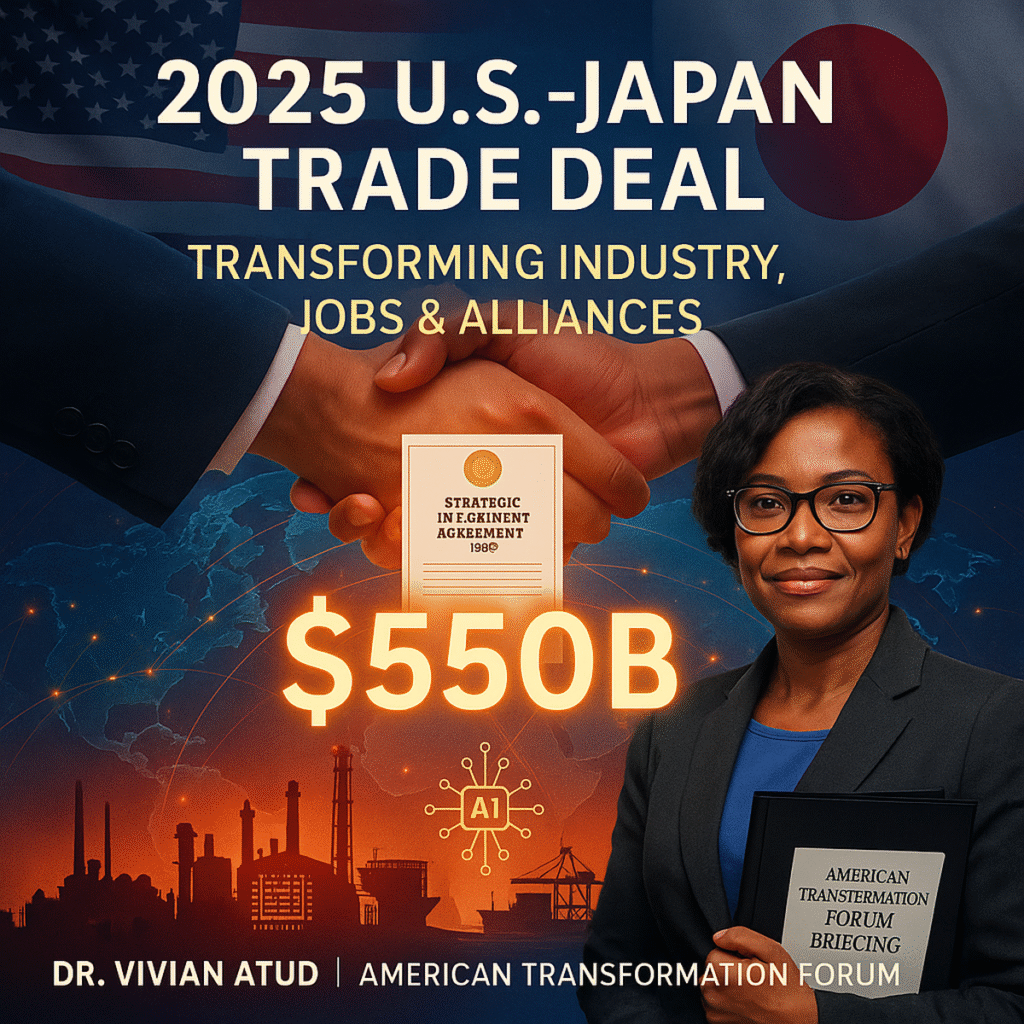Inside the 2025 U.S.–Japan Trade Deal, What the $550B Agreement Means for Jobs, Industry, and Global Alliances
Dr. Vivian Atud
Senior Policy Researcher | Founder, American Transformation Forum
A Personal Reflection
I’ve sat across the table from policy ministers in Africa and economic planners in Washington. I’ve also stood in church basements, and union halls. I’ve heard tech CEOs talk about AI as “the next gold rush,” and I’ve heard laid-off workers wonder if they’ll ever find meaningful work again.
So when I read the July 2025 Fact Sheet announcing a $550 billion U.S.–Japan Strategic Trade and Investment Agreement, I didn’t just see a deal—I saw people. Families. Futures.
And that’s how we must look at this: not just as a headline, but as a turning point that will affect American jobs, global alliances, and the soul of our industrial economy.
What’s In the Deal?
On July 23, 2025, the White House unveiled what it called the largest foreign direct investment commitment in American history. In partnership with Japan, the U.S. secured:
-
A $550 billion strategic investment vehicle;
-
A tariff reduction from 25% to 15% on selected Japanese imports (notably autos, machinery);
-
Expanded Japanese access to U.S. ports and energy markets;
-
U.S. access to Japanese investment in critical industries—semiconductors, energy, AI, pharmaceuticals, and shipbuilding;
-
A promise to deepen economic, technological, and industrial cooperation in the Indo-Pacific.
“We are securing not just a trade deal, but an alliance for prosperity.”
— President Donald J. Trump, July 2025 (WhiteHouse.gov)
What This Could Mean for America
1. A Manufacturing Comeback?
If done right, this deal could revitalize American industry. The sectors prioritized—AI infrastructure, semiconductors, clean energy, shipbuilding—aren’t just buzzwords. They’re the foundations of the next economy. Japanese capital could help retool dormant U.S. factories, retrain workers, and build global supply chain resilience.
2. Economic Diplomacy in Action
In a time of rising geopolitical uncertainty, this deal sends a clear message: America is open for business, but only to trusted partners. It positions Japan as our key co-architect in shaping ethical, secure, and innovative markets in the Indo-Pacific.
3. Potential Jobs and Small Business Gains
With the right local implementation, communities across America could see a ripple effect: construction jobs, supplier contracts, export opportunities for rural agriculture, and federal grants linked to industrial development zones.
But Let’s Not Pretend It’s All Win-Win
1. Where’s the Transparency?
Right now, the numbers sound exciting—but the structure is unclear. Who oversees the $550B investment vehicle? How are profits shared? What’s enforceable and what’s aspirational?
We need more than press releases—we need public governance mechanisms.
2. Will U.S. Auto and Steel Workers Pay the Price?
Lowering tariffs on Japanese imports—especially cars and equipment—may hit already struggling U.S. manufacturing hubs. Union leaders from the Midwest are sounding the alarm, fearing job losses from uneven competition.
3. No Legal Binding Yet
Tokyo and Washington disagree on critical details—including profit-sharing and semiconductor duties. There is no formal treaty—just a mutual commitment. Without congressional ratification, future administrations could walk back these promises, leaving states and industries vulnerable.
What Congress and the Senate Must Do
As someone who’s helped governments draft trade protocols and investment reforms, I urge our lawmakers: don’t just applaud this deal—shape it.
1. Demand Quarterly Reporting
We need transparency on where the money is going, how it’s spent, who benefits, and whether the promised results—jobs, factories, exports—materialize.
2. Include Labor & Industry Safeguards
Require built-in protections for sectors likely to face increased Japanese competition—especially autos, steel, and small-scale U.S. exporters. This could mean rebates, retraining, or support for innovation zones.
3. Ensure Local Communities Have a Say
Create incentives for public-private partnerships that include local voices—mayors, unions, HBCUs, women-owned enterprises—so prosperity is shared.
4. Codify the Agreement
Congress must authorize a legal framework that binds this partnership into a long-term, enforceable treaty—not just a handshake between governments.
Key Recommendations (at a Glance)
| Policy Concern | Recommendation |
|---|---|
| Transparency | Require public reporting of fund deployment, job impact, and regional equity |
| Accountability | Establish a U.S.–Japan oversight commission with labor, academic, and civil society representation |
| Industrial safeguards | Require impact studies before major tariff reductions; consider carve-outs for vulnerable sectors |
| Legal grounding | Move toward treaty-level ratification with full congressional review and authorization |
Final Thoughts: A Deal Is Only as Strong as Its People
This deal has immense potential. But I’ve been in too many rooms where big numbers were promised and small communities were forgotten.
If we want this agreement to be remembered not just as a financial triumph—but as a transformational moment in U.S. economic justice and international cooperation—then Congress, the Senate, governors, mayors, and everyday citizens must stay engaged.
Let’s make this agreement work for people—not just portfolios.
Check out the GTF Research
Check out events
Connect with us on facebook
connect with us on linkedIn
Check out the American Transformation forum
Dr. Vivian Atud, Ph.D.
Founder | American Transformation Forum
Global Strategy Advisor | Podcast Host
For policy dialogues, speaker engagements, or private briefings: info@drvivanatud.com
